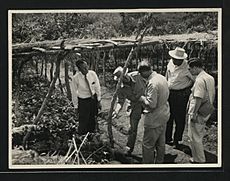Coffee production in Cameroon facts for kids
Coffee production is very important for the economy of Cameroon. Cameroon grows a lot of coffee. Two main types are robusta (found near the coast) and arabica (grown in the western mountains). Farmers grow two kinds of arabica: Java and Jamaïca. Java coffee plants are stronger against diseases like coffee berry disease and rust. In 2014, Cameroon was the 31st largest producer of coffee in the world.
Contents
History of Coffee in Cameroon
Coffee growing in Cameroon started a long time ago, in 1884. This was during the German colonial era. The Germans set up special gardens to test growing coffee. These gardens were in places like Victoria, Ebolowa, Nkongsamba, and Dschang.
Later, coffee farms spread to other areas. These included Yokadouma, Abong-Mbang, and Akonolinga. Around 1927, coffee plants reached the West Region. By 1928, 200,000 coffee seedlings were planted in Dschang. A French engineer named René COSTE helped a lot with coffee farming.
In 1990, Cameroon produced a record 156,000 tons of coffee. This made Cameroon the 12th largest coffee producer globally. Production later went down. This was due to government policies and a worldwide economic slowdown. The government has since invested money to help coffee farmers.
Where Coffee is Grown
Coffee is grown in seven regions of Cameroon. These regions are West, Northwest, Littoral, Southwest, South, Centre, and East.
The high mountain areas like Bamileke and Bamaoun are where arabica coffee grows. Robusta coffee is more common in Cameroon. It grows in lower mountain areas in the western region. Both arabica and robusta coffee are partly processed in Cameroon.
The Ministries of Agriculture and Rural Development (MINADER) and Scientific Research and Innovations (MINRESI) help manage coffee production. They have projects to grow more coffee. In 2013, Cameroon produced 41,800 tons of coffee. This was from an area of 212,000 hectares.
Selling Cameroon's Coffee
The National Cocoa and Coffee Board (NCCB) controls how coffee is sold in Cameroon. This is a government group.
Over the years, coffee sales have dropped. This happened after the government allowed more free trade in the early 1990s. In 2014, Cameroon sold 32,808 tons of its coffee.
Many companies export coffee from Cameroon. Some of the main exporters include Olam-Cameroon, UTI, UCCAO, and NWCA.
Plans to Boost Coffee Production
On September 30, 2014, the government launched a new plan. They want to boost coffee production. The goal is to produce 120,000 tons of robusta coffee by 2020. They also aim for 35,000 tons of arabica coffee by 2020. To pay for this plan, the government increased taxes on coffee exports.
See also
 In Spanish: Producción de café en Camerún para niños
In Spanish: Producción de café en Camerún para niños


